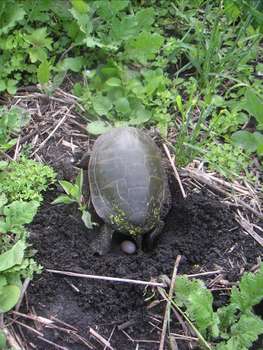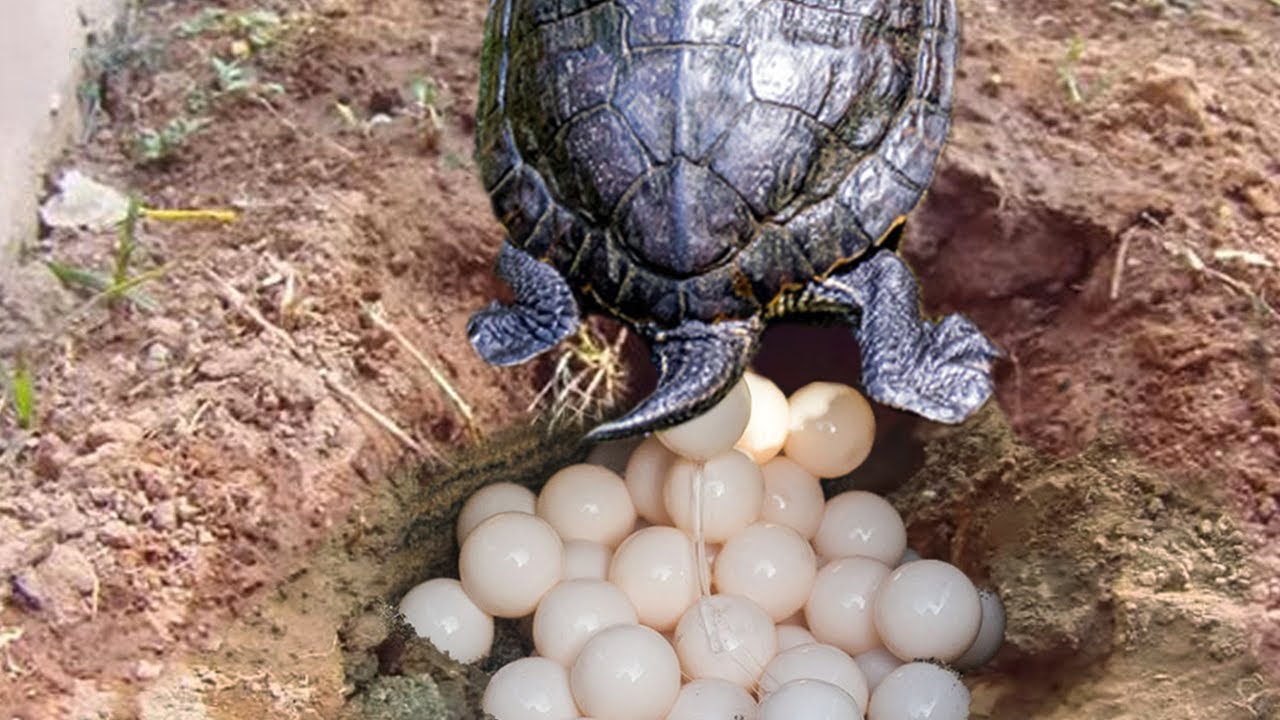Painted turtle eggs typically hatch in 72-80 days after being laid in the nest. Painted turtles, known for their vibrant shells, lay their eggs in nests dug into sandy soil.
These nests provide a safe incubation environment for the eggs. The eggs are left to develop on their own until they hatch, which usually occurs between 72 to 80 days after being laid. Once the young turtles are ready to emerge, they use their egg tooth to break out of the shell and make their way to the surface.
The hatching process marks the beginning of the painted turtle’s journey into the world, where they will eventually join their aquatic habitat and thrive in their natural environment.

Credit: www.turtleguardians.com
Painted Turtle Reproduction
Painted turtle eggs typically hatch in late summer or early fall, after an incubation period of about 72-80 days. The hatchlings emerge from their nests and make their way to the nearest water source. This process is crucial for the survival of the species.
Painted Turtle Reproduction Mating Behavior Painted turtles typically mate during the spring and early summer. Mating behavior is a fascinating display as the males actively court the females by swimming around them and fluttering their long claws. Once the female is ready to mate, the male will mount her shell and copulation occurs in the water. Nesting Process After mating, the female painted turtle searches for a suitable nesting site, often choosing sandy or loose soil near the water. She then uses her hind limbs to dig a nest cavity, where she lays her eggs. The number of eggs laid can vary, with a typical clutch size ranging from 4 to 20 eggs. Once the eggs are laid, the female covers the nest and returns to the water, leaving the eggs to incubate. Painted turtle eggs usually hatch in late summer or early fall, approximately 72 to 80 days after being laid. The hatchlings emerge from the nest and make their way to the water, where they will spend the winter hibernating at the bottom of the pond or stream. In conclusion, the mating behavior and nesting process of painted turtles are intriguing aspects of their reproduction cycle, showcasing the unique adaptations and behaviors of these fascinating reptiles.Egg Development
Painted turtle eggs undergo a fascinating process of development before hatching. Understanding the stages of egg development is crucial in ensuring the successful hatching of these precious reptiles.
Incubation Period
The incubation period for painted turtle eggs typically lasts 60 to 90 days. During this time, the eggs are carefully nurtured in their nest, awaiting the right conditions for hatching.
Environmental Influences
Environmental influences play a significant role in the development of painted turtle eggs. Factors such as temperature, humidity, and soil composition can impact the incubation process and ultimately determine the success of hatching.
Signs Of Hatching
Painted turtle eggs follow a specific timeline for hatching, and there are several signs to look for when anticipating the arrival of the hatchlings. Understanding these signs can help you prepare for the exciting event of new life emerging from the eggs.
Nest Disturbance
Nest disturbance is a common indicator that the painted turtle eggs are close to hatching. This includes noticing any changes to the nest site, such as the soil being disturbed or the presence of small holes or cracks in the ground above the eggs.
Egg Movement
Egg movement can be observed as the eggs get closer to hatching. You may notice slight shifts in the position of the eggs or see them vibrating slightly. This movement is a clear indication that the hatchlings are preparing to emerge.

Credit: fmr.org
Hatching Process
Painted turtle eggs typically hatch in late summer, usually around 72 to 80 days after being laid. The hatching process is influenced by temperature, with warmer conditions leading to quicker hatching. Once hatched, the baby turtles make their way to the water, where they begin their journey to adulthood.
Painted turtles are one of the most common turtle species found in North America. They are known for their brightly colored shells and unique patterns. If you are lucky enough to come across a painted turtle nest, you might be curious about when the eggs will hatch. In this blog post, we will discuss the hatching process of painted turtle eggs and what you can expect to see.Breaking The Egg Shell
The hatching process of painted turtle eggs typically takes around 60 to 80 days, depending on the temperature. Once the eggs are ready to hatch, the baby turtles will start to break through the eggshell. They use a special egg tooth to break open the shell, which falls off shortly after hatching.Emergence From Nest
After the baby turtles have broken through the eggshell, they will stay in the nest for a short time. This allows them to absorb the remaining yolk sac, which provides them with nutrients. Once the yolk sac has been absorbed, the baby turtles will start to emerge from the nest. They will make their way to the surface and start their journey towards the water. It’s important to note that painted turtles are born with a strong instinct to head towards the water. If the nest is not close to a water source, the baby turtles will still be able to find their way there. In conclusion, the hatching process of painted turtle eggs is a fascinating sight to see. From breaking through the eggshell to emerging from the nest, these baby turtles are equipped with everything they need to start their journey towards the water. If you happen to come across a painted turtle nest, be sure to give these little guys plenty of space and observe from a distance.Survival Challenges
Painted turtles are a common sight in North America, and they are known for their bright colors and unique patterns. However, their survival is not always guaranteed, especially during the hatching process. Painted turtle eggs face a range of challenges that can impact their chances of survival.
Predation Risks
One of the most significant challenges that painted turtle eggs face is the risk of predation. Many animals, including raccoons, skunks, and birds, prey on turtle eggs. These predators can easily locate the nests and dig them up, causing significant damage to the eggs.
To minimize the risk of predation, painted turtles bury their eggs in sandy or loamy soils. This type of soil is easier to dig through, which makes it more difficult for predators to locate the nests. Additionally, female turtles can lay their eggs in several locations, further increasing the chances of survival for some of the eggs.
Natural Threats
Aside from predators, painted turtle eggs also face a range of natural threats. Extreme weather conditions, such as drought or heavy rain, can significantly impact the hatching process. For example, during a drought, the eggs may not receive enough moisture, causing them to dry out and die. Alternatively, heavy rain can flood the nests, causing the eggs to drown.
Other natural threats include diseases and parasites, which can infect the eggs and impact their development. For example, fungi can grow on the eggs, causing them to rot and die.
Conclusion
Painted turtle eggs face a range of challenges during the hatching process. Predation, extreme weather conditions, diseases, and parasites are just some of the factors that can impact the survival of these eggs. However, painted turtles have evolved several strategies to increase the chances of survival for their eggs, such as burying them in sandy soils and laying them in multiple locations.

Credit: www.youtube.com
Conservation Efforts
Conservation efforts play a crucial role in ensuring the survival of painted turtle populations. Through targeted initiatives and community involvement, the protection of nesting sites and the hatching of turtle eggs can be effectively supported.
Protection Of Nesting Sites
Protecting the nesting sites of painted turtles is essential for the successful hatching of their eggs. Efforts to safeguard these areas from human interference, habitat destruction, and pollution are crucial in ensuring the survival of the species. By implementing protective measures such as fencing off nesting areas and raising awareness about the importance of these sites, conservationists can significantly contribute to the preservation of painted turtle populations.
Community Involvement
Engaging the local community in conservation efforts is vital for the long-term success of painted turtle conservation. Through educational programs, volunteer initiatives, and collaborative projects, community members can actively participate in protecting nesting sites and supporting the hatching of turtle eggs. By fostering a sense of responsibility and awareness among the public, these efforts can positively impact the overall conservation of painted turtles.
Conclusion
As we eagerly await the hatching of painted turtle eggs, the anticipation grows. The miraculous process of new life emerging from these delicate shells is a reminder of nature’s wonders. Stay patient and observant as these tiny hatchlings make their way into the world, adding beauty to our surroundings.






Leave a Reply